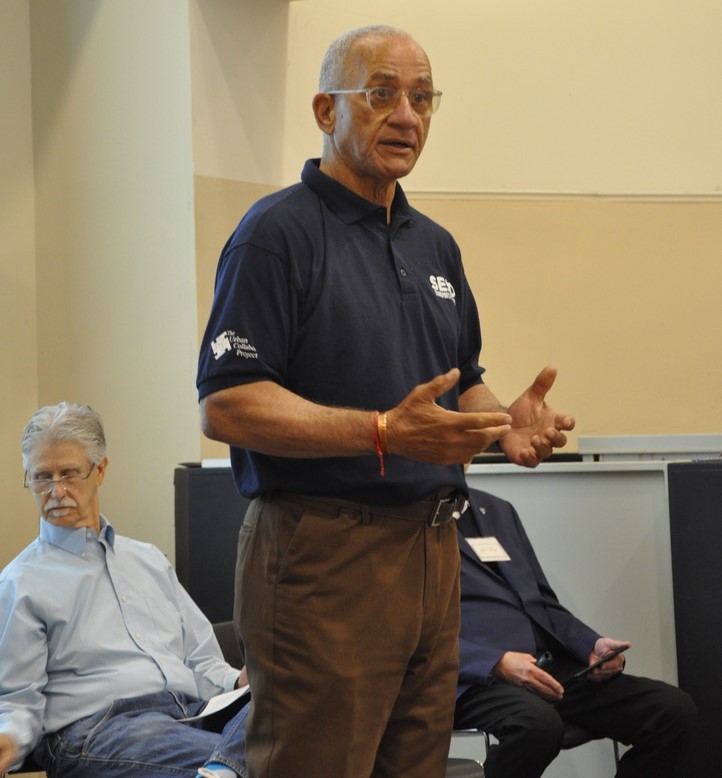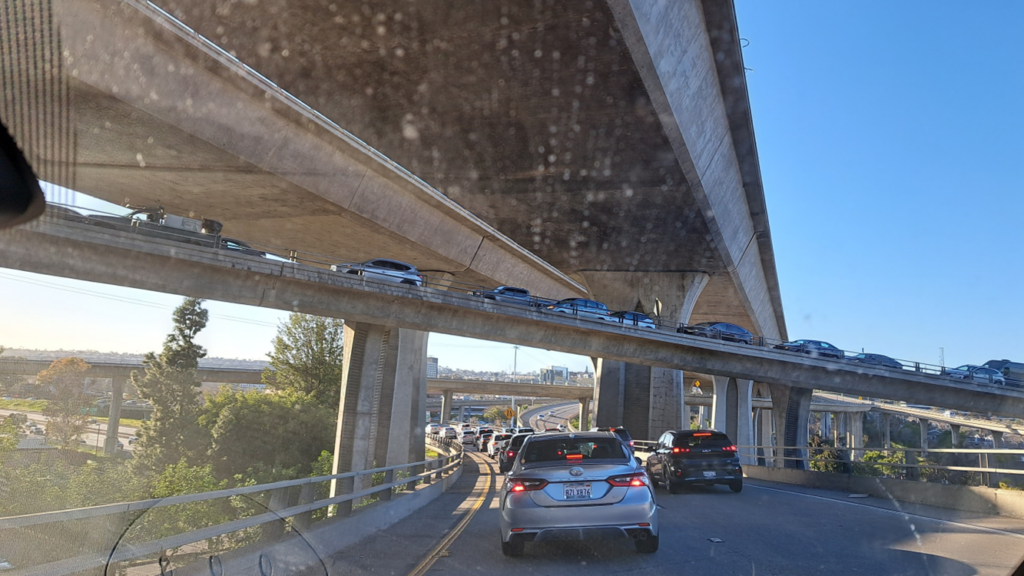
More than fifty community participants, panelists, advocates, and experts participated in a community workshop on microtransit organized by SanDiego350 on Saturday, March 4, at the Malcolm X Library in southeast San Diego.
Barry Pollard of the Urban Collaborative Project welcomed the participants and laid out the challenge to decision-makers to stop speaking of equity and start doing something to address transportation inequities in communities south of Route 8.
Microtransit refers to pooled rides in shared vans running on fixed or on-demand routes and schedules serving locations within a zone that is underserved by last-mile connections to transit. John Niles, a renowned transportation expert and co-author of the book, The End of Driving, provided an introduction for those unfamiliar with microtransit and discussed the need for the service, the benefits to underserved communities, and the costs associated with microtransit.
Sanjiv Nanda of SanDiego350 pointed out that the need for microtransit has been well established. Technology in the form of six to twelve-seat electric vehicles, and software for scheduling, pickups and dropoffs exist already and have been matured in hundreds of pilots across the country. SANDAG’s Flexible Fleets Implementation Strategic Plan published last fall provides a comprehensive analysis and planning for deployment. So all the pieces necessary to move forward are in place.
Rani Narula-Woods of Los Angeles Metro Micro runs the largest publicly operated rideshare service in the United States. LA Metro Micro is deployed in nine zones in LA County providing first-mile/last-mile coverage to underserved neighborhoods. Ms Narula Woods shared lessons from the last two years and highlighted the need to identify sustained funding sources.


A panel consisting of representatives of public, non-profit, and private providers shared diverse perspectives.
April DeJesus of SANDAG described the strategic planning process that SANDAG has undertaken to identify and prioritize microtransit pilot zones within the region. Prioritization criteria include density of short trips within a zone, social equity considerations including low-income, minority, and senior population, and proximity to transit. SANDAG is assisting local jurisdictions to apply for funding to launch pilots in these priority zones in partnership with private providers.
Krystal Ayala of the City of San Diego noted that FRED (Free Rides Everywhere Downtown) is funded from downtown parking meter revenues. Since 2016, FRED has served over 1.1 million passengers. Using a similar funding model, SANDAG and the City of San Diego have partnered to target a summer 2023 launch of the PB Shuttle connecting Pacific Beach with the Balboa Transit Station on the Blue Line Trolley.

Carolina Martinez of the Environmental Health Coalition highlighted the Ten Transit Life Lines developed by the San Diego Transportation Equity Group. As an immigrant from Colombia, she noted that when she was growing up, privately run mini buses provided her with an independence that school kids in San Diego also deserve to have. Krista Glotzbach of Via Transportation noted how different jurisdictions across the country have incorporated and integrated microtransit into their local transit plans. In San Diego, the first-mile/last-mile service must supplement and integrate with the substantial route structure provided by MTS and NCTD. She also indicated the potential for efficiencies of scale to integrate local microtransit with non-emergency medical transport.

The panelists and experts then joined the participants for small group table discussions. They were provided the following questions to guide the discussion:
- What transportation options are available to you in your community right now? What could be done to make it easier for you and your neighbors to get around?
- How can you access transit (bus or trolley) from your home? From your place of work? From school? From shopping? From healthcare?
- How might microtransit meet the needs of your community?

Over the final 45 minutes, workshop participants shared the highlights of the small group discussions for consideration by the panelists. Questions raised by the groups included:
- Why aren’t the cost/benefit analyses of microtransit widened to include measures of social equity?
- How can microtransit be funded?
- Can Google directions be configured to include microtransit?
- Would microtransit accommodate people with disabilities?
- Given that people are not easily convinced to take conventional transit, how would you get them to take microtransit?
- How can we offer microtransit to seniors and others who may not use apps and the internet?


Our research and advocacy work on microtransit continues. The SanDiego350 Transportation Team works on advancing equitable and sustainable transportation in the region, including improved access to transit, VMT reduction, and decarbonization of transportation. To join our team please send an email to: Steven Gelb steve@sandiego350.org.
WHY MICROTRANSIT?
Microtransit supplements our regional transit network by providing convenient connections to trolley and express bus service and local destinations in the service zone at a low fixed cost per ride.
Microtransit lowers the monthly household transportation budget by serving those who do not own a private car, including students, low income households, and seniors. It reduces the need for a first or second private car.
Microtransit reduces traffic congestion and greenhouse gas emissions by replacing single occupancy trips with shared rides.Microtransit expands the footprint for affordable housing development by connecting the entire zone to regional trolley and express bus service. It reduces the need for parking at trolley stations.
All photos thanks to Bee Mittermiller.
| To learn more, read SD350’s blog post on Microtransit: https://sandiego350.org/2022/10/04/microtransit-will-reduce-transportation-inequity-and-boost-transit-ridership-in-san-diego/Download our white paper: https://drive.google.com/file/d/10RnxPu_JDo1rKUPBB1pNPSTWQr4WF0MR/view |
1 The Flexible Fleets Implementation Strategic Plan can be downloaded from: https://www.sandag.org/projects-and-programs/innovative-mobility/flexible-fleets
